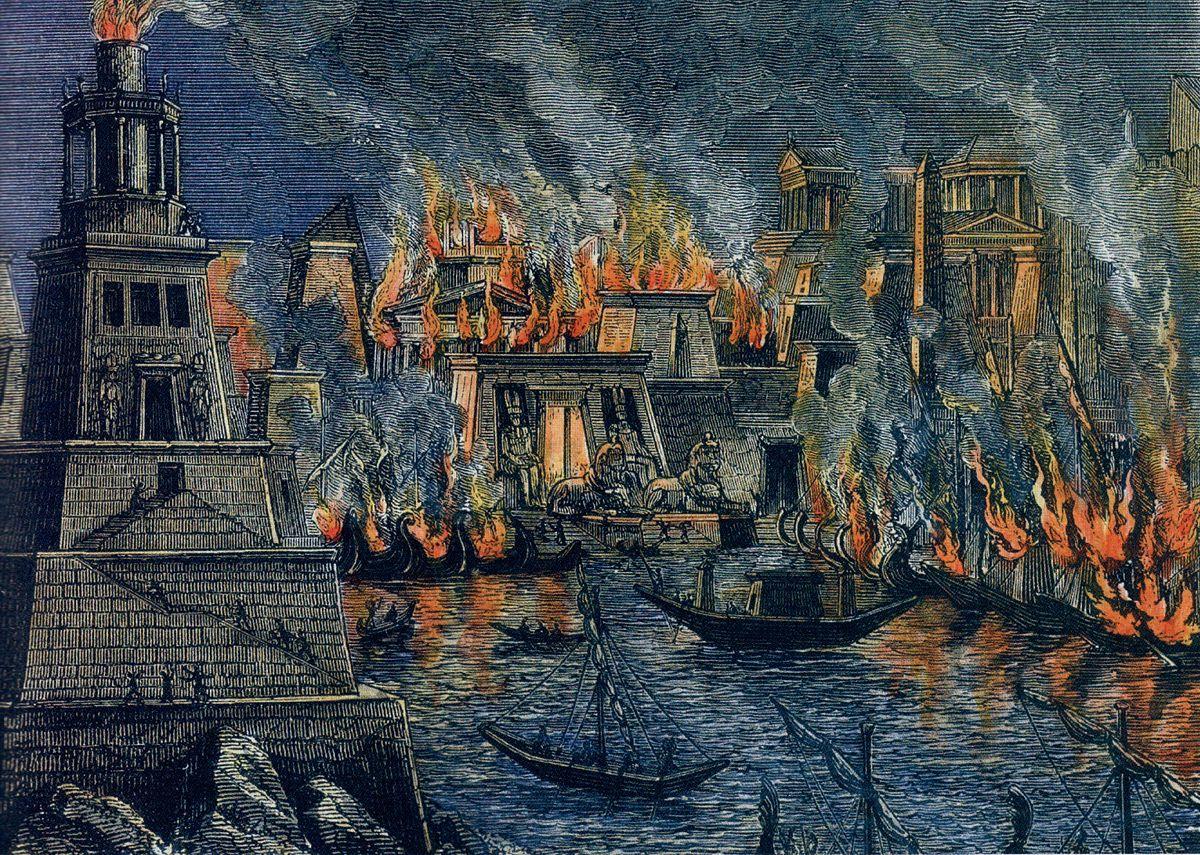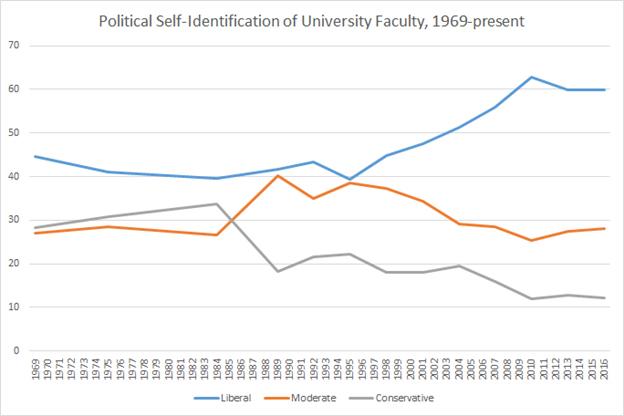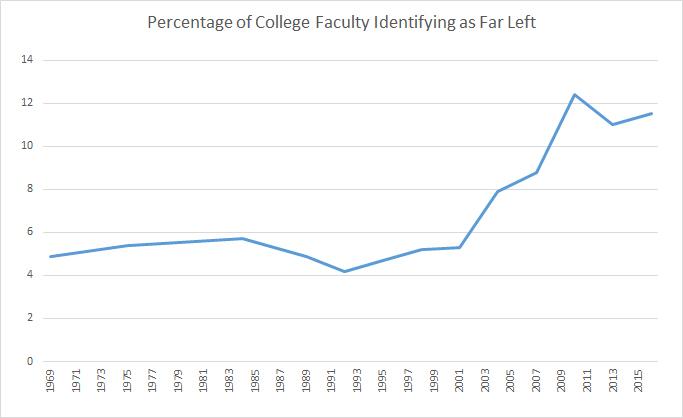Authored by Phillip Magness via The American Institute for Economic Research,
College professors have long positioned themselves to the political left of the American public. The progressive skew in higher education used to be a stable plurality though. Beginning with the earliest survey data in the 1960s, self-identified left-liberals consistently comprised, on average, about 43 percent of all college professors in the United States. Self-described “moderate” and “conservative” faculty members split the remainder for the next three decades.
Then something changed around the year 2001. The percentage of faculty who identify with the political left began to skyrocket. In the course of under 15 years, left-leaning faculty rose to an outright majority of 60 percent of the professoriate.
The leftward tilt of the university is depicted in the chart below, which includes the recently released results of the 2016-17 faculty survey from the Higher Education Research Institute (HERI) at UCLA. The latest results confirm and extend earlier observations about the same ideological skew.
The three lines are unfortunately limited by the category choices, but include “liberal” and “Far Left” (blue), “moderate” (red), and “conservative” and “Far Right” (grey). They nonetheless provide a clear illustration that the progressive turn is now the new normal in higher education.
Source: Carnegie Foundation surveys of higher education (1969-84), HERI Faculty Survey (1989-present)
Political skews in higher education are nothing new, and taken alone may not even be a problem if they reflected a stable long-term pattern. But the recent sharp leftward turn of the professoriate after 2001 is a clear break from historical norms.
It also carries implications for faculty who fall outside of the university system’s progressive majority. Faculty who identify to the right of center have taken the greatest hit, dropping from 28 percent in the late 1960s and 22 percent as recent as 1995 to only 12 percent today.
A closer look at the data reveals that the shift does not reflect subtle changes in the U.S. political mainstream. Rather, it appears to be driven by a sharp rise in the subset of “liberal” faculty who identify as “Far Left.” As the chart below illustrates, this number more than doubled between 2001 and 2010 and now sits at near parity with the total number of conservatives in the academy.
Source: Carnegie Foundation surveys of higher education (1969-84), HERI Faculty Survey (1989-present)
The leftward shift is also unique to faculty. Comparable surveys of both university students and the American public show that left and right political identification remained completely stable during the same period that faculty opinion moved in a radical direction.
The Rise of the Hyper-politicized Faculty
In illustrating these recent trends, I have no intention of stating what the proper balance should be between faculty on the left and right (to say nothing of omitted categories such as classical liberal/libertarian). Rather, the data speak to an alarming pattern in which our university faculty have become hyper-politicized around a single ideological pole.
As recently as 20 years ago the academy exhibited a relatively stable diversity of political perspectives. Now it is skewed heavily toward a single “consensus” ideology that constitutes a clear majority of the professoriate. At the same time, non-leftist voices have been squeezed out of the academy due to a combination of retirements and an emerging bias in faculty hiring that appears to privilege progressive political beliefs.
The observed political skews have also played out unevenly across academic disciplines, concentrating heavily in subjects that lend themselves to political content. Professors in the humanities and social sciences skew much further to the left than the physical sciences. Over 80 percent of English professors, for example, identify on the political left. Subjects such as history, political science, sociology, and fine arts typically approach or exceed 70 percent. In short, the humanities and social sciences have become ideological monoliths.
The only fields with a semblance of ideological balance tend to be pre-professional programs such as business and the so-called STEM majors in science and engineering — all areas where political opinion is less likely to appear in instructional content or research. Contrary to popular mythology, humanities-faculty hiring growth has also outpaced the STEM fields in the last two decades, which further helps to explain the source of the ideological skew.
The Echo Chamber Effect
The hyper-politicization of academia shows few signs of dissipating anytime soon, although it appears to be taking a toll on the most severely afflicted disciplines. Monolithic ideological echo chambers make for poor incubators of research as they insulate their participants from outside challenges. The recently observed crisis of rigor in scholarly research, exemplified by the recent wave of hoax articles being accepted for publication in ostensibly scholarly outlets, is directly symptomatic of an associated collapse in the safeguards and standards of peer review.
But also note another trend at play. The most ideologically skewed academic disciplines also correlate closely with recent woes in attracting students to their classrooms.
A 2018 report by the American Historical Association tracked trends in undergraduate majors by subject area over the previous six years using Department of Education data. The most severe declines in the number of degree seekers occurred in fields such as history, religion, English, foreign languages, political science, fine arts, and the humanities in general.
Perhaps not coincidentally, these same subjects have all become hyper-politicized in the last 15 years. The HERI survey indicates that 65, 70, or even 80 percent of the faculty in these disciplines identify on the political left. Similar measures using political-party data from faculty voter registrations show an even more pronounced skew, concentrated in the exact same subjects.
Are the hyper-politicized faculty ranks of these same fields driving away students? Multiplesurveys suggest that students outside of the progressive left self-censor their beliefs on campus, fearing both viewpoint discrimination and bias from faculty in grading. Recent empirical studies of faculty in psychology and law also reveal evidence of actual discrimination against viewpoints that fall outside of the progressive umbrella, particularly in academic hiring. It is not difficult to surmise how an extremely skewed professoriate in certain disciplines would make students with dissenting views feel unwelcome in their classrooms.
Students are currently abandoning the humanities and certain social sciences in droves. While faculty in these fields are apt to blame this problem on poltergeists such as the “devaluation” of their teaching (as Jason Brennan and I document in our new book, Cracks in the Ivory Tower) and exaggerated budgetary woes, the actual source seems to be that fewer and fewer students actually want what these subjects have to offer in the classroom.
With no small irony, the leftward hyper-politicization of the faculty in these subjects may also be a primary reason for their recent inability to attract majors outside of a small cadre of like-minded political activists.
via ZeroHedge News http://bit.ly/2UOfffS Tyler Durden


